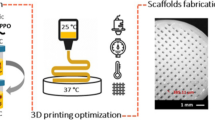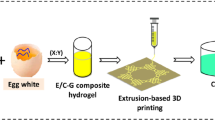Abstract
Traditional 3D printing materials are not suitable for tissue engineering due to their toxicity, low degradability and poor biocompatibility. In this study, a new amphiphilic biodegradable waterborne polyurethane (WBPU) was developed by a green and sustainable process without any organic solvents, catalysts or cross-linkers. The soft segments of this kind of WBPU were formed by replacing hydrophobic poly(ε-caprolactone) diol with hydrophilic poly(ethylene glycol) (PEG). Different block lengths of PEG were used for this purpose. The combination of ester and ether groups endowed WBPU with amphiphilic characteristics, which is important for regeneration and maintenance of tissue. The effects of composition and content of soft segments on the phase separation, thermal properties, mechanical properties, water absorption, biodegradability and cytotoxicity of WBPU were investigated. The results showed that the desired properties of WBPU could be achieved by tuning the block length of PEG and content of soft segments. The present work provided a new approach to prepare WBPUs with amphiphilic and biodegradable characteristics, which are promising candidates for 3D printing materials for tissue engineering scaffolds.













Similar content being viewed by others
References
Inzana JA, Olvera D, Fuller SM, Kelly JP, Graeve OA, Schwarz EM (2014) 3D printing of composite calcium phosphate and collagen scaffolds for bone regeneration. Biomaterials 35:4026–4034
Tarafder S, Balla VK, Davies NM, Bandyopadhyay A, Bose S (2013) Microwave-sintered 3D printed tricalcium phosphate scaffolds for bone tissue engineering. J Tissue Eng Regen Med 7:631–641
Wu G-H, Hsu S-h (2015) Review: polymeric-based 3D printing for tissue engineering. J Med Biol Eng 35:285–292
Han LH, Yu S, Wang T, Behn AW, Yang F (2013) Microribbon-like elastomers for fabricating macroporous and highly flexible scaffolds that support cell proliferation in 3D. Adv Funct Mater 23:346–358
Yen HJ, Hsu SH, Tseng CS, Huang JP, Tsai CL (2009) Fabrication of precision scaffolds using liquid-frozen deposition manufacturing for cartilage tissue engineering. Tissue Eng Part A 15:965–975
Chen Q, Liang S, Thouas GA (2013) Elastomeric biomaterials for tissue engineering. Prog Polym Sci 38:584–671
Suri S, Han LH, Zhang W, Singh A, Chen S, Schmidt CE (2011) Solid freeform fabrication of designer scaffolds of hyaluronic acid for nerve tissue engineering. Biomed Microdevices 13:983–993
Ovsianikov A, Malinauskas M, Schlie S, Chichkov B, Gittard S, Narayan R et al (2011) Three-dimensional laser micro- and nano-structuring of acrylated poly(-ethylene glycol) materials and evaluation of their cytoxicity for tissue engineering applications. Acta Biomater 7:967–974
Reininghaus W, Koestner A, Klimisch HJ (1991) Chronic toxicity and oncogenicity of inhaled methyl acrylate and n-butyl acrylate in Sprague-Dawley rats. Food Chem Toxicol 29:329–339
Kligerman AD, Atwater AL, Bryant MF, Erexson GL, Kwanyuen P, Dearfield KL (1991) Cytogenetic studies of ethyl acrylate using C57BL/6 mice. Mutagenesis 6:137–141
Lin ZF, Wu MM, He HM, Liang QF, Hu CS, Zeng ZW et al (2019) 3D Printing of mechanically stable calcium-free alginate-based scaffolds with tunable surface charge to enable cell adhesion and facile biofunctionalization. Adv Funct Mater 29:1808439
Hao HY, Shao JY, Deng Y, He S, Luo F, Wu YK et al (2016) Synthesis and characterization of biodegradable lysine-based waterborne polyurethane for soft tissue engineering applications. Biomater Sci 4:1682–1690
Hung KC, Tseng CS, Dai LG, Hsu SH (2016) Water-based polyurethane 3D printed scaffolds with controlled release function for customized cartilage tissue engineering. Biomaterials 83:156–168
Sartori S, Chiono V, Tonda-Turo C, Mattu C, Gianluca C (2014) Biomimetic polyurethanes in nano and regenerative medicine. J Mater Chem B 2:5128–5144
Wang Y-J, Jeng US, Hsu S-h (2018) Biodegradable water-Based polyurethane shape memory elastomers for bone tissue engineering. Acs Biomater Sci Eng 4:1397–1406
Nair LS, Laurencin CT (2007) Biodegradable polymers as biomaterials. Prog Polym Sci 32:762–798
Cai L, Heilshorn SC (2014) Designing ECM-mimetic materials using protein engineering. Acta Biomater 10:1751–1760
Cui H, Webber MJ, Stupp SI (2010) Self-assembly of peptide amphiphiles: from molecules to nanostructures to biomaterials. Pept Sci 94:1–18
Han DK, Park KD, Hubbell JA, Kim YH (1998) Surface characteristics and biocompatibility of lactide-based poly (ethylene glycol) scaffolds for tissue engineering. J Biomater Sci Polym Ed 9:667–680
Kutikov AB, Song J (2015) Biodegradable PEG-based amphiphilic block copolymers for tissue engineering applications. ACS Biomater Sci Eng 1:463–480
Veronese FM, Pasut G (2005) PEGylation successful approach to drug delivery. Drug Discov Today 10:1451–1458
Jiang X, Yu F, Wang Z, Li J, Tan H, Ding M, Fu Q (2010) Fabrication and characterization of waterborne biodegradable polyurethanes 3-dimensional porous scaffolds for vascular tissue engineering. J Biomater Sci Polym Ed 21:1637–1652
Wang Z, Yu L, Ding M, Tan H, Li J, Fu Q (2011) Preparation and rapid degradation of nontoxic biodegradable polyurethanes based on poly(lactic acid)-poly(ethylene glycol)-poly(lactic acid) and l-lysine diisocyanate. Polym Chem 2:601–607
Ma Z, Hong Y, Nelson DM, Pichamuthu JE, Leeson CE, Wagner WR (2011) Biodegradable polyurethane ureas with variable polyester or polycarbonate soft segments: effects of crystallinity, molecular weight, and composition on mechanical properties. Biomacromol 12:3265–3274
Hung K-C, Tseng C-S, Hsu S-H (2014) Synthesis and 3D printing of biodegradable polyurethane elastomer by a water-based process for cartilage tissue engineering applications. Adv Healthcare Mater 3:1578–1587
Yeong W-Y, Chua C-K, Leong K-F, Chandrasekaran M (2004) Rapid prototyping in tissue engineering: challenges and potential. Trends Biotechnol 22:643–652
Yen H-J, Hsu S, Tseng C-S, Huang J-P, Tsai C-L (2009) Fabrication of precision scaffolds using liquid-frozen deposition manufacturing for cartilage tissue engineering. Tissue Eng Part A 15:965–975
Hsu SH, Hung KC, Lin YY, Su CH, Yeh HY, Jeng US et al (2014) Water-based synthesis and processing of novel biodegradable elastomers for medical applications. J Mater Chem B 2:5083–5092
Guo M, Wyss HM (2011) Micromechanics of Soft Particles. Macromol Mater Eng 296:223–229
Fang CQ, Zhou X, Yu Q, Liu SL, Guo DG, Yu RE, Hu JB (2014) Synthesis and characterization of low crystalline water borne polyurethane for potential application in water-based ink. Prog Org Coat 77:61–71
Tao C, Luo Z, Bao J, Cheng Q, Huang Y, Xu G (2018) Effects of macromolecular diol containing different carbamate content on the micro-phase separation of waterborne polyurethane. J Mater Sci 53:8639–8652. https://doi.org/10.1007/s10853-017-1908-6
García-Pacios V, Jofre-Reche JA, Costa V, Colera M, Martín-Martínez JM (2013) Coatings prepared from waterborne polyurethane dispersions obtained with polycarbonates of 1,6-hexanediol of different molecular weights. Prog Org Coat 76:1484–1493
Princi E, Vicini S, Castro K, Capitani D, Proietti N, Mannina L (2009) On the micro-phase separation in waterborne polyurethanes. Macromol Chem Phys 210:879–889
Cakić SM, Ristić IS, Marinović-Cincović M, Špírková M (2013) The effects of the structure and molecular weight of the macrodiol on the properties polyurethane anionic adhesives. Int J Adhes Adhes 41:132–139
Yu L, Zhou L, Ding M, Li J, Tan H, Fu Q (2011) Synthesis and characterization of novel biodegradable folate conjugated polyurethanes. J Colloid Interface Sci 358:376–383
Ayres E, Oréfice RL, Yoshida MI (2007) Phase morphology of hydrolysable polyurethanes derived from aqueous dispersions. Eur Polym J 43:3510–3521
Mondal S, Martin D (2012) Hydrolytic degradation of segmented polyurethane copolymers for biomedical applications. Polym Degrad Stabil 97:1553–1561
Bogdanov B, Toncheva V, Schacht E, Finelli L, Sarti B, Scandola M (1999) Physical properties of poly(ester-urethanes) prepared from different molar mass polycaprolactone-diols. Polymer 40:3171–3182
Mondal S, Hu JL (2006) Structural characterization and mass transfer properties of nonporous-segmented polyurethane membrane: influence of the hydrophilic segment content and soft segment melting temperature. J Membr Sci 276:16–22
Mondal S, Hu JL (2006) Structural characterization and mass transfer properties of polyurethane block copolymer: influence of mixed soft segment block and crystal melting temperature. Polym Int 55:1013–1020
O’Sickey MJ, Lawrey BD, Wilkes GL (2002) Structure–property relationships of poly(urethane urea)s with ultra-low monol content poly(propylene glycol) soft segments. I. Influence of soft segment molecular weight and hard segment content. J Appl Polym Sci 84:229–243
Li F, Hou J, Zhu W, Zhang X, Xu M, Luo X (1996) Crystallinity and morphology of segmented polyurethanes with different soft-segment length. J Appl Polym Sci 62:631–638
Mondal S, Hu JL (2008) Structural characterization and mass transfer properties of dense segmented polyurethane membrane: influence of hard segment and soft segment crystal melting temperature. Polym Eng Sci 48:233–239
Wang T-L, Hsieh T-H (1997) Effect of polyol structure and molecular weight on the thermal stability of segmented poly(urethaneureas). Polym Degrad Stabil 55:95–102
Yashima E, Noguchi J, Okamoto Y (1994) Enantiomer enrichment of oxprenolol through cellulose tris(3,5-dimethylphenylcarbamate) membrane. J Appl Polym Sci 54:1087–1091
Coutinho FMB, Delpech MC (2000) Degradation profile of films cast from aqueous polyurethane dispersions. Polym Degrad Stabil 70:49–57
Pielichowski K, Pielichowski J, Altenburg H, Balloff H-J (1996) Thermische degradation von MDI-basierenden polyurethanen: charakteristische abhängigkeiten zwischen den zersetzungsparametern. Thermochim Acta 284:419–428
Chattopadhyay DK, Webster DC (2009) Thermal stability and flame retardancy of polyurethanes. Prog Polym Sci 34:1068–1133
Król P (2007) Synthesis methods, chemical structures and phase structures of linear polyurethanes. Properties and applications of linear polyurethanes in polyurethane elastomers, copolymers and ionomers. Prog Mater Sci 52:915–1015
Migneco F, Huang YC, Birla RK, Hollister SJ (2009) Poly(glycerol-dodecanoate), a biodegradable polyester for medical devices and tissue engineering scaffolds. Biomaterials 33:6479–6484
Liu N, Zhao Y, Kang M, Wang J, Wang X, Feng Y (2015) The effects of the molecular weight and structure of polycarbonatediols on the properties of waterborne polyurethanes. Prog Org Coat 82:46–56
Hou LJ, Ding YT, Zhang ZL, Sun ZS, Shan ZH (2015) Synergistic effect of anionic and nonionic monomers on the synthesis of high solid content waterborne polyurethane. Colloid Surface A 467:46–56
Zhang T, Zhang HF, Zhang LQ, Jia SJ, Liu J, Xiong Z, Sun W (2017) Biomimetic design and fabrication of multilayered osteochondral scaffolds by low-temperature deposition manufacturing and thermal-induced phase-separation techniques. Biofabrication 9:025021
Tokiwa Y, Suzuki T, Takeda K (1988) Two types of lipases in hydrolysis of polyester. Agric Biol Chem 52:1937–1943
Kamath KR, Park K (1993) Biodegradable hydrogels in drug delivery. Adv Drug Deliv Rev 11:59–84
Hao HY, Deng Y, Wu YK, Liu SY, Lin WW, Li JH et al (2018) Synthesis of biodegradable waterborne phosphatidylcholine polyurethanes for soft tissue engineering applications. Regen Biomater 4:69–79
Wang C, Zheng YD, Sun Y, Fan JS, Qin Q, Zhao Z (2016) A novel biodegradable polyurethane based on poly(3-hydroxybutyrate-co-3-hydroxyvalerate) and poly(ethylene glycol) as promising biomaterials with the improvement of mechanical properties and hemocompatibility. Polym Chem 7:6120–6132
Funding
This study was funded by science and technology project from Jilin Province Ministry of Education (Grant No. JJKH20191304KJ).
Author information
Authors and Affiliations
Corresponding author
Ethics declarations
Conflict of interest
The authors declare that they have no conflict of interest.
Additional information
Publisher's Note
Springer Nature remains neutral with regard to jurisdictional claims in published maps and institutional affiliations.
Rights and permissions
About this article
Cite this article
Yang, Z., Wu, G. Effects of soft segment characteristics on the properties of biodegradable amphiphilic waterborne polyurethane prepared by a green process. J Mater Sci 55, 3139–3156 (2020). https://doi.org/10.1007/s10853-019-04237-6
Received:
Accepted:
Published:
Issue Date:
DOI: https://doi.org/10.1007/s10853-019-04237-6




